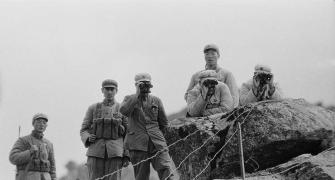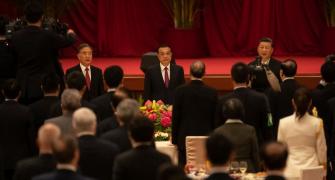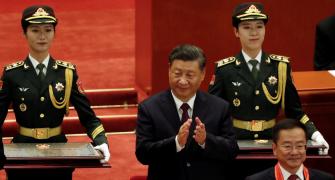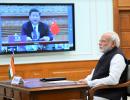China has chosen to keep New Delhi guessing, while retaining for itself the option of constantly changing facts on the ground and shifting the LAC westwards -- the strategy called 'salami slicing', notes Ajai Shukla.

In early 1950, the year after the Chinese Communist party established the People's Republic of China, two army groups of the People's Liberation Army began a race to 'liberate' Tibet.
From Sichuan province, the South-Western Army, with a young Deng Xiaoping as its political commissar, set off from Chengdu to Lhasa.
Meanwhile the North-Western Army started from Xinjiang under the leadership of the formidable Fan Ming.
Given the wild, unpopulated terrain the North-Western Army had to traverse, compared to the relatively easy journey from Sichuan, Deng comfortably won, leading to bad blood between the two invading armies.
Alongside the subjugation of Tibet, a key PLA priority became the construction of a highway linking Xinjiang with Tibet -- so that future Fan Mings could travel more quickly and easily between China's biggest and most restive autonomous republics.
There is an apocryphal element to the tale about India's envoy to China, Sardar K M Panikkar, opening the newspaper one morning in 1957 and learning about the completion of the Western Highway through Indian-claimed Aksai Chin -- something that was confirmed later by Indian intelligence patrols.
What is certain is that the PLA's early history, and its current strategic movement corridors, make that highway, numbered G-219, a prize to be zealously guarded from a perfidious India that has never reconciled to the loss of Aksai Chin or to the 'assimilation' of Tibet into China.
Amongst the unannounced motivations that drove PLA troops into Ladakh this summer, Highway G-219 surely figures.
The terrain buffers needed for its protection affect PLA calculations of where the Line of Actual Control should run.
Beijing has never divulged where it believes the LAC runs and it did little to remedy that when it told an Indian newspaper in Beijing recently that the Sino-Indian border clearly followed the LAC, as it stood on November 7, 1959.
Declaring tautologically that China had announced it in the 1950s, Beijing said 'the international community, including India, are very clear about it.'
Over the last 150 years, a plethora of Sino-Indian borders has been drawn in Ladakh by Great Britain, China and India.
Each has served a selfish purpose and, for that reason, has never been accepted by the other parties.
Notwithstanding that, the delineation that really matters today is an agreed LAC.
But China has never unambiguously revealed its perception of the LAC, with clear map coordinates, choosing instead to keep New Delhi off-balance and guessing, while retaining for itself the option of constantly changing facts on the ground and shifting the LAC westwards -- the strategy called 'salami slicing'.
Even so, since China has now put a date on its claim, it is worth recalling the various claim lines since the mid-19th century.
Everyone seemed content with an undefined boundary until the advance of colonial powers into the region brought Britain into confrontation with the southward-expanding Russia -- a competition for influence that became known as the Great Game.
Britain, hoping to set up a weak China as a buffer against the Russian advance, sought to draw up a boundary with it.
A Forward School of British strategists, exemplified by Lord Curzon, wanted a boundary deeper into Xinjiang, while a more pragmatic Moderate School was opposed to the expense and effort of placing troops and administration in far flung areas.
Over the second half of the 19th century, British frontier policy oscillated between the Forward School and the Moderate School.
The former drew up the ambitious Johnson-Ardagh Line, which ran along the Kuen Lun Range and included the Aksai Chin in India.
The latter developed the Macartney-MacDonald Line, which ran along the Karakoram and Laktsang ranges and left Aksai Chin to China.
When India became independent in 1947, maps of that time depicted eastern Ladakh as 'undefined' territory.
But in its first maps, drawn a few years later, independent India embraced the Forward School approach, showing the boundary with China along the Kuen Lun and placing Aksai Chin in India.
China steadfastly ignored all of Britain's 19th century proposals, as also the McMahon Line that was drawn up in the 1914 Simla Conference.
Only in 1956 did China, now an assertive power, produce its first map.
This depicted the Aksai Chin in China, with the boundary running along the Karakoram range.
Even so, the 1956 alignment left to India the Depsang Plain, the valleys of the Chip Chap, Qara Qash and Galwan rivers, the Hot Spring area, most of the Pangong Lake and a part of the Spanggur Lake.
Then Chinese premier Zhou Enlai affirmed this boundary in 1959 in a letter to then prime minister Jawaharlal Nehru -- in which, for the first time, reference was made to a 'line of actual control'.
In the 1960 Officials Dialogue, the Chinese delegation presented a new version of the boundary that shifted the 1956 line substantially westwards.
In explaining this, the Chinese said the 1960 line was an updated and more accurate version of the 1956 line.
The 1960 line claimed much of Depsang, the Qara Qash and Galwan River valleys and all of the Spanggur Lake. At Pangong Lake, the boundary ran through Sirijap.
With the Chinese capturing chunks of Indian territory in the 1962 War, the LAC moved westwards again.
At the end of the war, the PLA undertook to withdraw 20 km from where it had advanced to, but its withdrawal was selective.
Compared to pre-war positions, China had occupied an additional 3,500 square km of Indian territory.
However, in several places, China withdrew from areas it had claimed in 1960, including Depsang and the Galwan River valley.
The Indian Army gradually reoccupied these areas, setting up picquets in some places while, in others, designating patrolling points that our troops would periodically visit to assert our claim.
Now, by attempting to deny India these same areas -- Depsang, Galwan River valley and much of the Pangong Tso -- China appears to be reasserting the 1960 line.
However, it seems contradictory for Beijing to invoke the November 1959 LAC after transgressing that line at multiple points this year.
Former foreign ministry officials recount that, in 1983-1984, the two sides were discussing a possible 'East for West' boundary settlement that involved India ceding the Aksai Chin in return for China ceding Arunachal Pradesh.
At the time, the Indian Army had provided our foreign ministry negotiators maps marked with our interpretation of the LAC, which also showed the additional territory occupied by China in the 1962 operations.
The Indian side had informally proposed a 'LAC-plus solution' which involved China also returning the territory occupied in 1962 to sweeten the 'East for West' package proposal.
Till today, Beijing does not formally accept any difference between the post-1962 line and the November 1959 line.
However, the negotiators point out that it tacitly did accept the difference in 1983-1984, by a willingness to consider the 'LAC-plus solution'.
These multiple ambiguities became jarringly apparent in 1993 while negotiating the Peace and Tranquillity Agreement.
In that agreement, New Delhi and Beijing agreed to clarify the LAC by sharing their respective alignments, including through exchange of maps.
But the Chinese continue stalling this and multiple versions of the LAC continue to exist.










